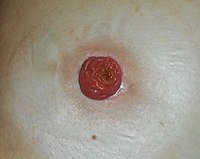
Photo from wikipedia
Large amounts of waste are generated by the minimally processed vegetables industry, such as those from beetroot processing. The aim of this study was to determine the best method to… Click to show full abstract
Large amounts of waste are generated by the minimally processed vegetables industry, such as those from beetroot processing. The aim of this study was to determine the best method to obtain flour from minimally processed beetroot waste dried at different temperatures, besides producing a colorant from such waste and assessing its stability along 45 days. Beetroot waste dried at 70 °C originates flour with significant antioxidant activity and higher betalain content than flour produced from waste dried at 60 and 80 °C, while chlorination had no impact on the process since microbiological results were consistent for its application. The colorant obtained from beetroot waste showed color stability for 20 days and potential antioxidant activity over the analysis period, thus it can be used as a functional additive to improve nutritional characteristics and appearance of food products. These results are promising since minimally processed beetroot waste can be used as an alternative source of natural and functional ingredients with high antioxidant activity and betalain content.
Journal Title: Journal of Food Science and Technology
Year Published: 2017
Link to full text (if available)
Share on Social Media: Sign Up to like & get
recommendations!